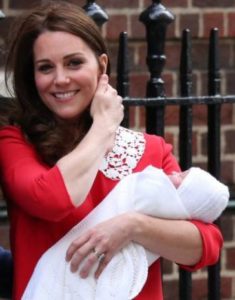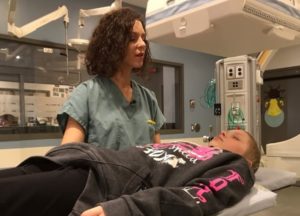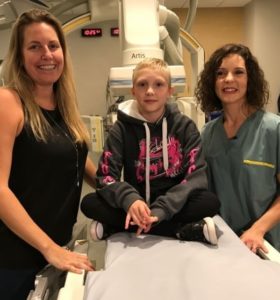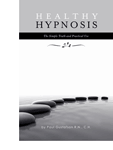
 As the world seems to be changing before our eyes, we are left with the daunting task of coping with it all. How do we rationalize and make sense of such an extreme situation? This is uncharted territory for all of us.
As the world seems to be changing before our eyes, we are left with the daunting task of coping with it all. How do we rationalize and make sense of such an extreme situation? This is uncharted territory for all of us.
The initial instinct is ‘fight or flight’ or panic, which has led to hoarding food supplies and even toilet paper of all things. Retail stores, banks, concert halls, schools, malls, universities, stadiums and restaurants are all closed; sports teams are on hiatus and once busy roadways are now strangely manageable.
We are all left with the task of learning social distancing, elbow bumps, frequent hand washing and sanitizing anything that is ever touched. There is no where to go and not much to do as we all try to figure out what happened to the world we knew just a few weeks ago?
So now, with all sorts of time on our hands, we can get to the business of gathering important information, but where do you turn and who do you trust? 24-hour news outlets have time to fill, competitors to beat and advertisers to satisfy.
Sure, they want to report what you need to know, but to support their bottom line, they need to keep you tuned in and the best way to do this is to maintain a sense of urgency and fear. If we take the bait, we get sucked into an emotional roller coaster resulting in significant ongoing stress and hopelessness. Overtime this can affect sleep, appetite, mood and overall healthy well-being.
So what do we do? What do we actually have control of? We can certainly control how and when we gather daily news updates. We can control the frequency our physical activities like healthy exercise which stimulates endorphin flow creating a sense of euphoric relaxation.
We can also seek out uplifting stories that have resulted from this tragedy like the Italian residents singing together from their apartment windows as a sign of unity. Or the police officer in Somerville, MA who handed out toilet paper instead of tickets
 As a hypnotherapist, I teach my clients to control their pattern of thought, how they think and what they most frequently think about. Hypnosis or meditation is a great way to emotionally disconnect from outer world thoughts and to focus within; to spend more time thinking about and anticipating sustained comfortable relief.
As a hypnotherapist, I teach my clients to control their pattern of thought, how they think and what they most frequently think about. Hypnosis or meditation is a great way to emotionally disconnect from outer world thoughts and to focus within; to spend more time thinking about and anticipating sustained comfortable relief.
By repeating this process daily the subconscious becomes conditioned to follow this new relaxing path. You will still be doing what you do and going where you go, but you will feel much better about it. We can’t control what comes our way but we most definitely have control over how we see it and more importantly how it makes us feel.
You don’t necessarily need to see a hypnotherapist or attend a meditation class to get the job done. There is no shortage of great meditation apps as well as an endless array of free hypnosis sessions on YouTube. You will be pleasantly surprised how much better you’ll feel in the middle of everything that is going on around you.
By: Paul Gustafson RN CH
Kate Middleton confirmed the long-rumored this past weekend, that she practiced a form of self-hypnosis when she delivered her royal babies George, Charlotte and Louis.
“I saw the power of it,” the Duchess of Cambridge said of hypnobirthing during a podcast for Happy Mum, Happy Baby.
The growing “mommy trend” was first described by Marie “Mickey” Mongan in her 1989 book, HypnoBirthing: A Celebration of Life, and is based on the tenet women birth instinctively and that labor need not be painful if the woman is properly prepared, relaxed and supported.
“I help them become aware of how magical that body is,” Mongan, who was inspired by Grantly Dick-Read, an 1890-born British obstetrician and leading advocate of natural birthing, said in an interview before her death last year at 86.
“People have not been letting women feel magical and so that’s why they think they need drugs and they need all these other things.” Instead, all women need “is to relax and go inside and let their body do whatever it wants to do,” Mongan maintained.
It was hugely powerful
For her part, the Duchess said she discovered hypnobirthing while struggling with hyperemesis gravidarum, a brutal form of morning sickness.
 While stressing hypnobirthing isn’t for everyone, “it was through the hyperemesis that I really realized the power of the mind over the body,” Kate said.
While stressing hypnobirthing isn’t for everyone, “it was through the hyperemesis that I really realized the power of the mind over the body,” Kate said.
“I’m not going to say that (Prince) William was standing there sort of, chanting sweet nothings at me. He definitely wasn’t. I didn’t even ask him about it, but it was just something I wanted to do for myself.”
“It was hugely powerful,” Kate said, adding she “quite liked labor,” primarily because she knew it was going to end.
The birthing method uses visualization, deep abdominal breathing (rather than the short, shallow breaths favored by other childbirth methods), guided imagery and deep relaxation techniques (self-hypnosis) to encourage a calm and natural birth.
“When women understand that pain is caused by constrictor hormones created by fear,” reads the HypnoBirthing Canada website, “they learn, instead, to release fear, thus creating endorphins, the feel-good hormones.”
For $500 or so, the Mongan method is taught in group, or one-on-one private sessions, and is particularly appealing to women with tokophobia — a pathological terror of giving birth.
Proponents say hypnobirthing increases the chances for a drug-free and shorter labor , women are less likely to have a caesarean section or suffer post-natal depression and that hypnobirthed infants have higher Apgar scores, a test used to assess a newborn’s color, heart rate, reflex, muscle tone and breathing.
Studies suggest most pregnant women would prefer birth not be interfered with unless medically necessary.
However, one 2013 study of 2,400 American women’s childbirth experiences found 67 per cent received an epidural, 62 per cent an intravenous catheter, 47 per cent bladder catheters and 31 per cent the drug oxytocin to start or hurry up labor.
“With such a large gap between the desired and the achieved, are we as providers and childbirth educators doing all that we can to help these women obtain their goal?” California midwife and nurse practitioner Corry Varner wrote in The Journal of Perinatal Education.
The Society of Obstetricians and Gynecologists of Canada recommends non-drug approaches to help women cope with the intensity of labor due to their “numerous” benefits, including a reduction in the need for C-sections.
Among the approaches the society supports is the “Central Nervous System Control” mechanism, which consists of focusing the woman’s attention using relaxation, visualization and “auto-hypnosis.”
The evidence for hypnobirthing, however, is patchy.
A 2016 Cochrane review that included nine trials in which 2,954 women in total were randomized to hypnosis or control groups found women in the hypnosis group were 27 per cent less like to use pain-relieving drugs during labor.
But there was no difference in the use of epidurals (a procedure that injects a local anesthetic into the space around the spinal nerves in the lower back.) Women using hypnosis were also no more likely to have a normal vaginal birth and there were no clear differences in their sense of how well they coped with labor.
Another 2015 study published in BJOG: An International Journal of Obstetrics and Gynecology involving 680 women randomized to “usual care” or usual care plus brief self-hypnosis training found that attending two 90-minute hypnosis sessions at around 32 and 35 weeks’ gestation didn’t reduce epidural use but did reduce birth fear and anxiety.
It’s entirely possible longer courses of hypnosis training starting earlier in pregnancy might have had an impact, the authors acknowledged. And there was no evidence of extra risk for either mother or baby.
Another review published in 2011 in Clinical Psychology Review involving 13 studies found “hetero-hypnosis” (when one person hypnotizes another) and self-hypnosis “were consistently shown to be more effective than standard medical care, supportive care or childbirth education classes in reducing pain.”
Other researchers have found that women who use hypnotherapy during labor are also more likely to have consulted with an acupuncturist or naturopath, attend yoga or meditation classes during pregnancy and use herbal medicines, aromatherapy oils, homeopathy and other alternative therapies.
According to a 2016 study of 2,445 Australian women, they were also “less commonly identified as feeling safer knowing that an obstetrician is providing their care and were more likely to labor in a birth center or in a community center (i.e. at home).”
Kate safely birthed all three of her babies in the exclusive private Lindo Wing of London’s St. Mary’s Hospital.
Diana, Princess of Wales, was also determined to have given birth without drugs — though some accounts suggest she had an epidural at a late stage of her 16-hour labor with Prince William.
The reason we have pain is because we’re fearful and we tense up
During Prince Harry’s birth, she reportedly read a paperback novel until the last three hours and sucked on ice cubes.
Quebec hypnotherapist Ilona Fritsch, of HypnoBirthing Canada, offers classes in Montreal, Laval and Saint-Sauveur.
The program consists of five, two-and-one-half hour classes over a period of five weeks. Women and couples are also urged to practice hypnobirthing meditations and affirmations daily until the baby’s birth.
“The reason we have pain is because we’re fearful and we tense up,” Fritsch said. “If we get rid of the fears and concerns about birth then there’s a good chance we won’t have any pain, that we’ll be comfortable during labor and have a faster birth.”
Critically, the program teaches the father or birth partner how to help the woman remain calm through the surges and protect her “bubble of positivity,” according to the Mongan method’s teaching.
While the goal is a natural, drug-free birth, “I tell women, ‘if you feel that you need an epidural at one point, it’s not a failure, it’s OK. Don’t think that everything is going to be bad just because you took the epidural,’” Fritsch said.
Women don’t go into a trace. There’s no swinging watch. Rather, according to the official HypnoBirthing Institute website, the experience is similar to daydreaming, or the “focusing that occurs” when one is engrossed in a good book, or a movie.
While women might feel “some discomfort,” it’s not pain, as such, Fritsch said. “If you ask them while they are in labor, they say, ‘I feel sensations. I feel tension in my belly.’ But they never call it pain.”
Still, childbirth is a major physical and physiological event, and critics wrestle with the idea that hypnobirthing is “the secret” behind how Kate “was able to look so fresh” after her royal baby births.
Some see it as just another celebrity-endorsed, hippie birth fad (Gisele Bundchen and Jessica Alba are among the enthusiasts) that subtly chips away at women’s trust in mainstream medicine.
“When women are told they can get through what may be the most traumatic physical experience of their life just by thinking more positively about it, it can prompt those who need extra help — from the 60 per cent taking drugs for pain relief, to the small number who require an emergency caesarean — feel as if they failed in some way, even though the medical help they receive is based on decades of research into making pregnancy and birth safer,” Hannah Fearn wrote in The Independent.
By: Sharon Kirkey

 Some 80 pediatric patients took part in pilot project to test effect of hypnosis during stressful procedures.
Some 80 pediatric patients took part in pilot project to test effect of hypnosis during stressful procedures.
Even in a quick demonstration, Vicky Fortin, medical imaging technologist, was able to guide 9-year-old Koraly Lefrançois into a dreamlike state with hypnosis.
Koraly Lefrançois was diagnosed with Hodgkin’s disease last April and has had to undergo some pretty uncomfortable medical procedures at the Montreal Children’s Hospital since then.
The nine-year-old has had a catheter inserted into a peripheral vein and threaded through to her heart, in order for lifesaving treatments to be injected. She underwent a biopsy when a growth was discovered on her inner thigh.
In both procedures, a local anesthetic was used to ease her pain. But that does little to soothe anxiety.
That’s where hypnosis comes in.
“At first I was stressed, but after, I was less worried,” Koraly said. “The hypnosis calmed me down, and I was fine.”
Koraly is one of about 80 pediatric patients who participated in what is being touted as a successful pilot project at the Children’s — the use of medical hypnosis as a tool to combat stress and pain when undergoing arduous, protracted procedures.
On a pain and discomfort scale of zero to 10 (10 being the highest), the young patients averaged a score of 5.4 without hypnosis, researchers found.
Under hypnosis, the average score drops to 1.4. That’s a huge difference, said Johanne L’Écuyer, chief medical imaging technologist at the  Children’s.
Children’s.
Inspired by hospitals in France
L’Écuyer, who led the project, said the research team started with minor procedures, working their way up to longer, more difficult ones. The project ended in September, and now the use of hypnosis is increasingly common, she said.
“We do more and more. We do even more invasive procedures as we go,” L’Écuyer said.
“The more radiologists are seeing how powerful this is, the more they push to have hypnosis on longer procedures. Once we did a procedure that lasted two hours.”
Johanne L’Écuyer, chief medical imaging technologist at the Montreal Children’s, led the hypnosis pilot project. Hypnosis is now being used more and more, she says. (CBC)
The pilot project was initiated at the urging of Quebec’s order of medical imaging technologists. The order’s director attended a conference in France a few years ago and discovered the practice in use there.
When he returned to the province, he asked L’Écuyer if she’d like to look into it.
 She said she brought a team to France to visit hospitals, and “what we saw there was amazing.”
She said she brought a team to France to visit hospitals, and “what we saw there was amazing.”
Anne Zeestraten, left, says her daughter Koraly Lefrançois benefited from the hypnosis. Vicky Fortin, Koraly’s medical imaging technologist, says she could see her patient dreaming.
Koraly, who is now in remission, would dream while hypnotized, according to her medical imaging technologist, Vicky Fortin. Fortin would tell her young patient a relaxing story while she underwent each procedure.
“You could see her eyes moving under her eyelids, and that tells me that she’s dreaming,” Fortin recalled.”She’s somewhere else. She’s under hypnosis.” Koraly’s mother, Anne Zeestraten, said with the hypnosis, her daughter wasn’t scared when told she had to undergo a second procedure.
“She was like, ‘OK, yeah, just find some other dream.'”
By: Isaac Olson

 As the world seems to be changing before our eyes, we are left with the daunting task of coping with it all. How do we rationalize and make sense of such an extreme situation? This is uncharted territory for all of us.
As the world seems to be changing before our eyes, we are left with the daunting task of coping with it all. How do we rationalize and make sense of such an extreme situation? This is uncharted territory for all of us.
 As a hypnotherapist, I teach my clients to control their pattern of thought, how they think and what they most frequently think about. Hypnosis or meditation is a great way to emotionally disconnect from outer world thoughts and to focus within; to spend more time thinking about and anticipating sustained comfortable relief.
As a hypnotherapist, I teach my clients to control their pattern of thought, how they think and what they most frequently think about. Hypnosis or meditation is a great way to emotionally disconnect from outer world thoughts and to focus within; to spend more time thinking about and anticipating sustained comfortable relief.
 While stressing hypnobirthing isn’t for everyone, “it was through the hyperemesis that I really realized the power of the mind over the body,” Kate said.
While stressing hypnobirthing isn’t for everyone, “it was through the hyperemesis that I really realized the power of the mind over the body,” Kate said.

 Some 80 pediatric patients took part in pilot project to test effect of hypnosis during stressful procedures.
Some 80 pediatric patients took part in pilot project to test effect of hypnosis during stressful procedures. Children’s.
Children’s. She said she brought a team to France to visit hospitals, and “what we saw there was amazing.”
She said she brought a team to France to visit hospitals, and “what we saw there was amazing.”







